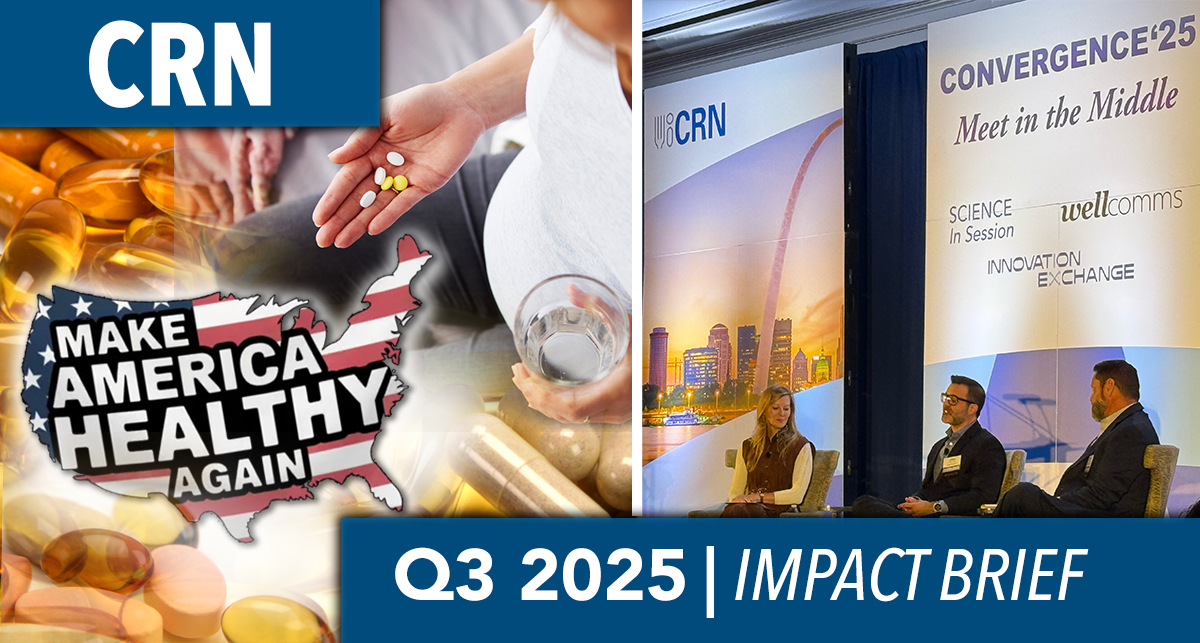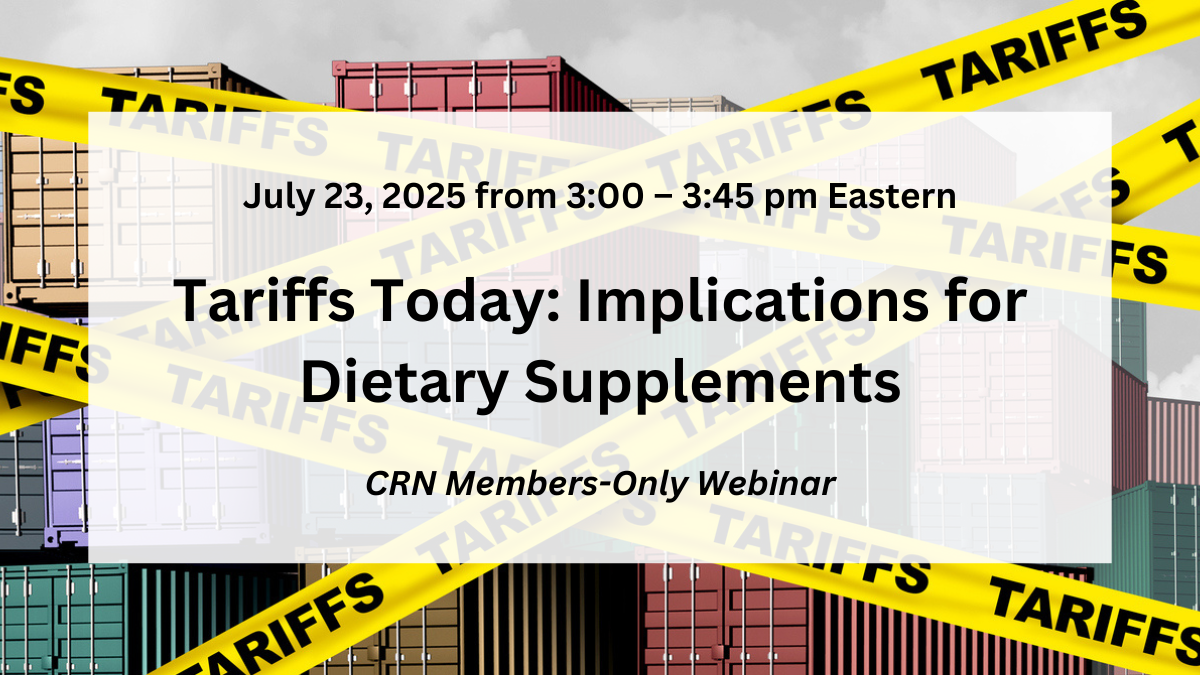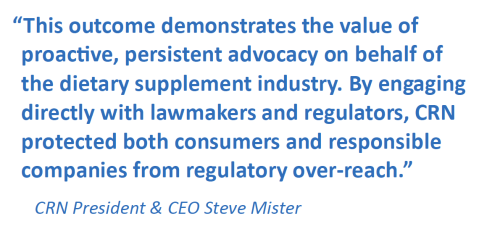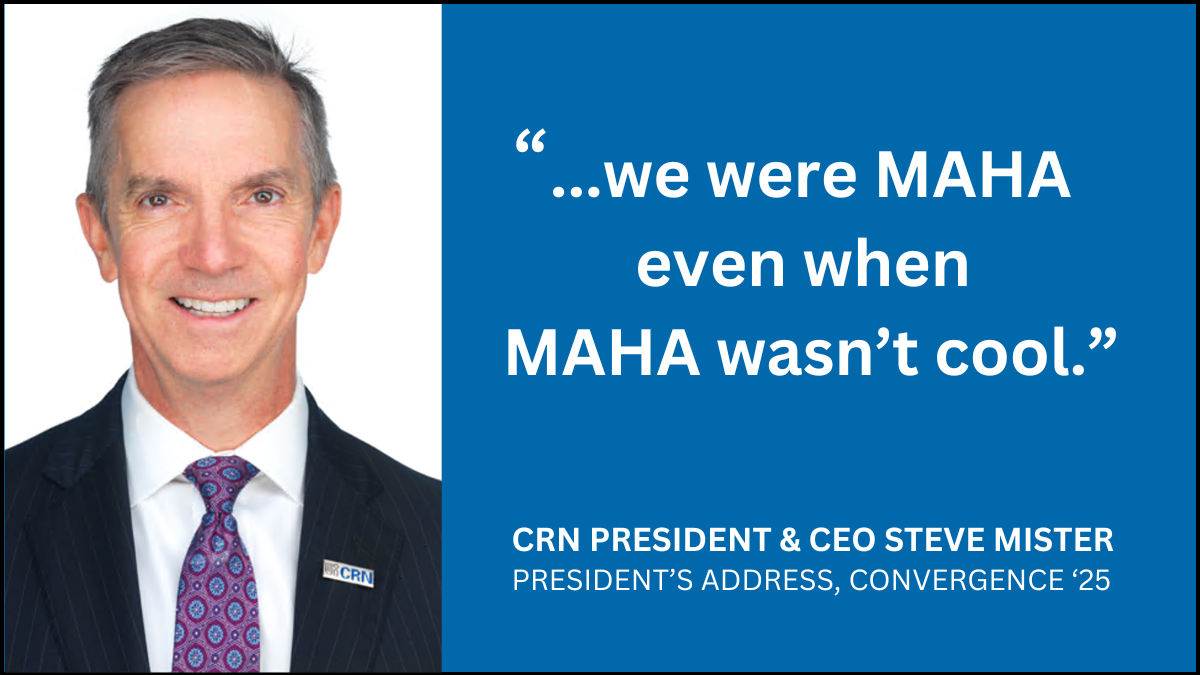SEE Q1 2025 REPORT | SEE Q2 2025 REPORT
In Q3, CRN delivered practical wins and resources members can use now to strengthen their position: California clarified that supplements aren’t “baby food,” our New York case was strengthened, and new HSA/FSA data showed modest cost with real consumer benefit. CRN helped members understand the moving target of tariffs, launched a turmeric task force, and provided educational and networking opportunities to support member interests moving into Q4 and looking ahead to 2026.
Download printable one-pager here.

LEANING IN TO RESPONSIBLE BEST PRACTICES IN TODAY’S MAHA LANDSCAPE; PROTECTING INDUSTRY, CONSUMER INTERESTS
CRN seized opportunities to engage in the Administration’s expressed vision to “Make America Healthy Again” (MAHA), while emphasizing its members’ self-regulatory leadership.
Following its Q1 welcome of Robert F. Kennedy, Jr., to his role as HHS Secretary, in August, CRN applauded his call for America’s medical education organizations to implement comprehensive nutrition education and training for the nation’s emerging healthcare professionals and in September, acknowledged the attention the “Make Our Children Healthy Again Report” brings to nutrition and the connections it identifies between proactive healthy behaviors and disease prevention—areas CRN has long emphasized as critical to improving public health.
President & CEO Steve Mister addressed MAHA in his presentation to attendees at CRN’s annual conference, providing examples of CRN’s efforts, including:
- Urging HHS and USDA to “meet people where they are” by acknowledging the role of dietary supplements in addressing persistent nutrient shortfalls in the 2025–2030 Dietary Guidelines for Americans.
- Advocacy to recognize of dietary supplements as a “qualified medical expense” in the tax code so that Americans can use the FSA/HSA funds to reimburse themselves for their supplement purchases.
- Addressing self-GRAS scrutiny by proposing more transparency and accountability in the process.
- Revising the 1997 Disclaimer Rule to clarify that the FDA disclaimer does not need to appear on every panel.
“The common thread in all these examples, is that the focus has always been, and continues to be, on ‘Making America Healthy,’ and I’m proud to be part of an industry that advances this mission,” said Mister in his president’s address.
- Several of CRN’s newer Voluntary Guidelines become effective this year, including updated melatonin guidelines now calling for label advisories and child deterrent packaging, and the e-commerce guideline for online sales that websites should contain all same content that is on the label.
- In response to increasing negative media articles about turmeric, CRN is launching a Turmeric Task Force working towards a voluntary program for the ingredient.
NAVIGATING TARIFFS WITH CLEAR GUIDANCE AND PRACTICAL NEXT STEPS
CRN met with various Administration officials on tariffs to make the case for exempting ingredients that cannot be produced in the U.S. or cannot be produced at a sufficient scale in the U.S. to meet demand. While conditions change regularly as new tariffs or individual trade deals are announced, CRN kept members informed with updates such as a new Executive Order updating Annex II and introducing New Annex III in early September and update on changes September 30.
 CRN advised members to verify HTS classifications and scope and consult customs brokers or trade counsel to understand product-specific impacts. CRN hosted a “Tariffs Today: Implications for Dietary Supplements” webinar in July (available on demand) that walked through reciprocal tariff mechanics, Section 232/301 actions, heightened CBP enforcement, and de minimis reforms that will sunset duty-free treatment for China and Hong Kong by July 2027—along with mitigation tactics companies are using in practice.
CRN advised members to verify HTS classifications and scope and consult customs brokers or trade counsel to understand product-specific impacts. CRN hosted a “Tariffs Today: Implications for Dietary Supplements” webinar in July (available on demand) that walked through reciprocal tariff mechanics, Section 232/301 actions, heightened CBP enforcement, and de minimis reforms that will sunset duty-free treatment for China and Hong Kong by July 2027—along with mitigation tactics companies are using in practice.
KEEPING UP WITH CALIFORNIA—A WIN, AND MORE WORK AHEAD
CRN reported a significant policy win in California with the enactment of SB 862 including clarification that dietary supplements are not subject to the state’s baby food testing and labeling requirements established under AB 899. “This clarification ensures that consumers continue to have access to safe, beneficial supplement products for their families without unnecessary regulatory confusion,” said CRN President & CEO Steve Mister in a press release. CRN will monitor the state’s implementation to ensure that supplements remain exempted, and member companies are not subject to unintended enforcement.
including clarification that dietary supplements are not subject to the state’s baby food testing and labeling requirements established under AB 899. “This clarification ensures that consumers continue to have access to safe, beneficial supplement products for their families without unnecessary regulatory confusion,” said CRN President & CEO Steve Mister in a press release. CRN will monitor the state’s implementation to ensure that supplements remain exempted, and member companies are not subject to unintended enforcement.
Regarding a separate measure, SB 646, which will require publicly posting raw heavy-metal test results of prenatal vitamins, Mister called for a veto, noting in a Capitol Weekly op-ed the law could unintentionally discourage women from taking prenatal supplements and push companies to strip essential nutrients to make labels look “cleaner.” CRN obtained compromise mitigating the law’s impact on industry—removing the label QR code requirement, changing monthly testing to lot testing (which we are doing anyway), and providing mandatory language for the testing websites to educate consumers with context about the unavoidable presence of minute levels of heavy metals. CRN will keep members informed as California Department of Public Health issues guidance.
STRENGTHENING OUR CASE IN NEW YORK AGE-RESTRICTION LITIGATION
CRN notified the Second Circuit of new case law, Upsolve v. James, decided in September, supporting its argument that New York’s law restricting the sale of certain dietary supplements marketed for weight loss or muscle building to consumers under 18 unconstitutionally regulates speech rather than conduct. CRN also detailed how New York’s age-restriction law on supplements is unconstitutional, preempted by federal law, and disruptive to interstate commerce, in response to the U.S. Department of Justice request for information.
Since enactment in October 2023, there has been no enforcement of the law. CRN believes its lawsuit is forestalling any actions by the New York Attorney General.
ADVANCING FSA/HSA INCLUSION OF SUPPLEMENTS WITH DATA-DRIVEN ADVOCACY
CRN conducted an analysis through John Dunham & Associates showing expansion of HSAs/FSAs to cover dietary supplements would have a $12.2B ten-year net fiscal impact—about 75% lower than earlier estimates—while improving consumer access. Most account holders don’t “spend down” balances (only 27% HSA / 36% FSA holders currently use these for OTC), suggesting limited but meaningful adoption. CRN also urged IRS to revise Publication 502 to classify supplements as qualified medical expenses—aligning tax policy with prevention.


